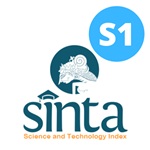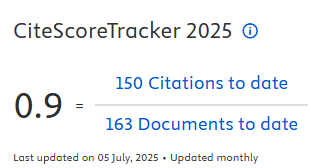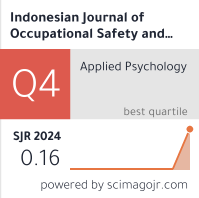Relations between Contact Duration, Type of Work Use of Personal Protective Equipment and Contact Dermatitis among Electroplaters
Downloads
Introduction: Occupational contact dermatitis is defined as a skin disorder that occurs after work and caused by work process. Electroplating is one of the jobs which has high contact dermatitis risk because there are irritant chemicals such as nickel and chromium. This study aimed to identify the relationship between risk factors for occupational-induced contact dermatitis and electroplaters at CV. X and CV. Y, Durungbanjar Village, Sidoarjo District. Method: This research was an observational study using cross-sectional approach. The sample was a total population of 28 people, consisting of 13 electroplaters at CV. X and 15 electroplaters at CV. Y in Durungbanjar Village. The study was conducted in November - May 2019. Data were collected using questionnaires, observations and medical record sheets. The variables in this study were contact duration, contact frequency, type of work and the use of personal protective equipment. Result: Result showed that 64.3% of electroplaters suffered from contact dermatitis. Contact duration factor had a very strong correlation of c = 0.764, contact frequency factor had a strong correlation of c = 0.710, type of work had strong correlation of c = 0.616, personal hygiene factor had strong correlation of c = 0.547 and the use of personal protective equipment also had strong correlation of c = 0.545. Conclusion: There is a very strong correlation between contact duration and contact dermatitis. Contact frequency, type of work and the use of personal protective equipment had strong correlation to contact dermatitis among electroplaters. The higher contact duration and frequency with irritant substances among the electroplaters, the higher the increase of the risk of contact dermatitis among the electroplaters. Some occupational efforts and recommendations can be made to reduce the risk of contact dermatitis.
Keywords: contact dermatitis, electroplating, risk factors
Belsito, D. V (2005) ‘Occupational Contact Dermatitis: Etiology, Prevalence, and Resultant Impairment/Disability', The Journal of the American Academy of Dermatology, 53(2), pp. 303–313.
Chafidz, M. and Dwiyanti, E. (2017) ‘Relationship of Long Contact, Type of Work and use of PPE with Dermatitis Cases of Contacts on Tofu Workers, Kediri', The Indonesian Journal of Occupational Safety and Health, 6(2), pp. 156–165.
Chew, A.-L. and Maibach, H. I. (2006) Irritant Dermatitis. Germany: Springer.
Cohen, D. E. (2019) ‘Occupational Dermatoses', in Mansdorf, S. Z. (ed.) Handbook of Occupational Safety and Health. 3rd edn. Canada: John Wiley & Sons, Inc, pp. 199–230.
Erliana (2008) Relationship between Individual Characteristics and the use Personal Protection Equipment (PPE) and the Incidence of Contact Dermatitis in the Paving Block Meker in CV. F Lhokseumawe. Thesis. Medan: Postgraduate Universitas Sumatera Utara.
Gautama, P. (2009) Know How to Coating Metal Parts (Part 1), Infometrik (Situs Informasi Mekanika, Material, dan Manufaktur).
Harrington, J. . and Gill, F. . (2005) Pocket Consultant Occupational Health. Edited by S. Kuswaji, A. C. Wijaya, and Y. J. Suyono. Jakarta: EGC.
Hudyono, J. (2002) ‘Occupational dermatitis', Majalah Kedokteran Indonesia, 49(9), pp. 16–23.
International Labor Organization (2015) Global Trends on Occupational Accidents And Diseases. Geneva: International Labor Organization.
Jeyaratnam, J. and Koh, D. (2010) Textbook Of Occupational Medicine Practice. Edited by R. N. E. Sihombing and Suryadi. Jakarta: EGC.
Lestari, F. and Utomo, S. H. (2007) ‘Factors Related to Contact Dermatitis on Workers at PT Inti Pantja Press Industri', Makara Kesehatan, 11(2), pp. 61–68.
Miaratiska, N. and Azizah, R. (2015) ‘Correlation Nickel Exposure and Worker Skin Health Disorders at Metal Plating Home Industry in Sidoarjo', Jurnal Kesehatan Lingkungan, 1(1), pp. 25–36.
Nuraga, W., Lestari, F. and Kurniawidjaja, L. M. (2008) ‘Factors Related to Occupational Contact Dermatitis on Workers Exposed to Chemicals used at Industrial Automotive Company.', Makara Seri Kesehatan, 12(2), pp. 63–69.
Orton, D. I. and Wilkinson, J. D. (2004) ‘Cosmetic Allergy: Incidence, Diagnosis, and Management', American Journal of Clinical Dermatology, 5(5), pp. 327–337.
Purwanto and Huda, S. (2005) Electroplating Industry Technology. Semarang: Badan Penerbit Universitas Diponegoro.
Rahma, G. A., Setyaningsih, Y. and Jayanti, S. (2017) ‘Analysis of the Relationship of Exogenic and Endogenic Factors on Dermatitis Events Due to Work n Leather Tanner Workers PT. Adi Satria Abadi Piyungan, Bantul', Jurnal Kesehatan Masyarakat FKM Undip, 5(5), pp. 173–183.
Rosenstock, L. et al. (2005) Textbook of Clinical Occupational and Environmental Medicine. 2nd edn. Washington: Saunders.
Sarwono, J. (2006) Quantitative and Qualitative Research Methods. Jakarta: Graha Ilmu.

In order to be accepted and published by The Indonesian Journal of Occupational Safety and Health, Author(s) who submit an article should complete all the review process. The copyright of received articles assigned to the The Indonesian Journal of Occupational Safety and Health and Department of Safety and Health, Universitas Airlangga as publishers of the journal. The intended copyright includes the rights to publish articles in various forms (including reprints).
The Editorial Team of The Indonesian Journal Of Occupational Safety and Health and Department of Safety and Health strive to ensure that no errors occur in the articles that have been published, both data errors and statements in the article.
Users of this website will be licensed to use materials from this website following the Creative Commons Attribution-NonCommercial-ShareAlike 4.0 International License. No fees charged. Please use the materials accordingly.
------------------------------------------------------------------------------------------------------------------------------------------------------------------------------------------
Attribution ” You must give appropriate credit, provide a link to the license, and indicate if changes were made. You may do so in any reasonable manner, but not in any way that suggests the licensor endorses you or your use.
NonCommercial ” You may not use the material for commercial purposes.
ShareAlike ” If you remix, transform, or build upon the material, you must distribute your contributions under the same license as the original.







 How to Submit Articles in OJS
How to Submit Articles in OJS

























